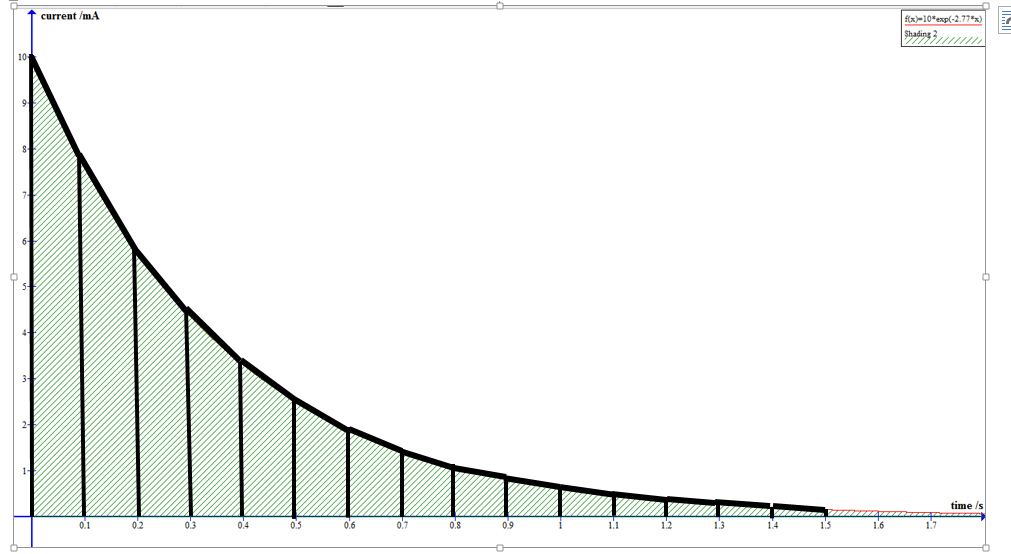i Need help for isaacphysics assignment please!!!!! ASAP!
Scroll to see replies
Original post by Smithenator5000
This is okay. You should now split the areas into trapeziums like this:

You can then calculate the area of each trapezium and add them together to get the total area. You can make the estimate more accurate by increasing the number of trapeziums.
You can then calculate the area of each trapezium and add them together to get the total area. You can make the estimate more accurate by increasing the number of trapeziums.
Original post by poonshark
Thanks , i've completed the assignments now. I much appreciate your help! so have you got any advise about AS levels ? i got A*s in the sciences at GCSE but i hear that A levels are a lot different and even A* students struggle ?
Indeed, it is the case that people who got A*s in GCSE science often struggle with A-level and I know many people who have found that. I believe that this is significantly due to the shift in focus and style of content for the different levels. I suppose it depends on your syllabus, but I found that whilst GCSE physics had a pretty large focus on 'how science works' and its impact in the everyday world, A-levels tend to have a greater focus on the science itself. It is also worth noting that at GCSE, a greater proportion of exam questions request qualitative responses as opposed to quantitative; A-levels appear to expect a higher level of mathematical fluency. That is why it is often an expectation for A-level physics students to take A-level maths as a means of maintaining said fluency.
In regards to advice, I would say that you should familiarise yourself with the structure and style of your board's exams. You should be aware that, due to A-level reform, the most relevant resources available at the moment are the specimen papers, which are papers which were never sat but serve as an example of what the exams should look like.
May I ask which syllabus you are on?
Original post by s.phx08
1.If a 50𝜇A current is flowing then how many electrons pass a point each minute to 2 significant figures?
2. In a bolt of lightning, 45nC flows to ground in 25ms. Work out the average number of charge carriers flowing past per second.
3. If 56×1016 electrons flow to the ground in 0.035𝜇s, work out the average current.
4. How long does it take for a current of 6.0A to deliver 1.5×1017 Cu2+ ions in a solution? Assume these ions are the only charged particles moving.
5. In an MgSO4 solution, a current of 36𝜇A flows. Work out how many SO2–4 ions pass a point in 15s. [Hint: assume that the Mg2+ ions and SO2–4 ions move at the same speed in opposite directions and the movement of each type of ion is responsible for half the current]
help
2. In a bolt of lightning, 45nC flows to ground in 25ms. Work out the average number of charge carriers flowing past per second.
3. If 56×1016 electrons flow to the ground in 0.035𝜇s, work out the average current.
4. How long does it take for a current of 6.0A to deliver 1.5×1017 Cu2+ ions in a solution? Assume these ions are the only charged particles moving.
5. In an MgSO4 solution, a current of 36𝜇A flows. Work out how many SO2–4 ions pass a point in 15s. [Hint: assume that the Mg2+ ions and SO2–4 ions move at the same speed in opposite directions and the movement of each type of ion is responsible for half the current]
help
Hi s.phx0,
Welcome to TSR.

I understand that you need help with these questions. However, this thread belongs to others and please start your own thread to solicit help.
In addition, please tell us what have you done or what is your problems in attempting the questions.
More helpers are willing to help/guide/advise when they see that you are putting in efforts to attempt the questions.
Have a nice day.

Original post by Smithenator5000
Hello there,
Notice that the y-axis (showing current in amperes) starts from , as opposed to . I believe that the question wants you to consider the area which includes that which has been omitted from the graph. Here is a diagram of what I am trying to describe.

You can now try calculating the area of this. Please reply if this doesn't work.
Smithenator5000.
Notice that the y-axis (showing current in amperes) starts from , as opposed to . I believe that the question wants you to consider the area which includes that which has been omitted from the graph. Here is a diagram of what I am trying to describe.
You can now try calculating the area of this. Please reply if this doesn't work.
Smithenator5000.
I am answering the same question and cannot figure it out at all. Can I have some guidance please?
Quick Reply
Related discussions
- Ethical Hacking Support!
- Missed all coursework deadlines
- Aiming an Oscilloscope Beam
- Unit 19 health and social care, HELP PLEASE!!
- Failing second year nursing assignments but passing placement?
- sociology paper structure help
- University assignments
- IsaacPhysics Discharging a Capacitor help
- differentiation help
- I think I’m going to get a third :/
- Disability student allowance
- Pearson BTEC Level 3 Applied Science Unit 21 Medical Physics Applications
- IsaacPhysics Summer Residential Course impact on Cambridge application
- LearnDirect Access to Social Science Unit 8 Introduction to Cognitive Psychology
- Did a completely wrong unit/module during the first term of my Second year, HELP!
- Missed deadline for picking modules
- A-Level Physics
- Unit 19: Study Skills Portfolio Building
- Unit 19 access to midwifery
- BTEC IT Level 3 Unit 5 - Cheese




